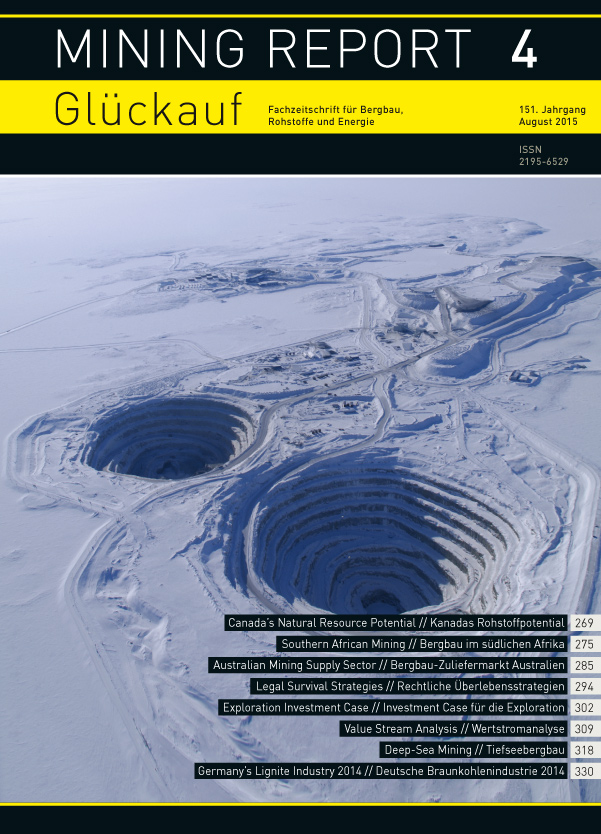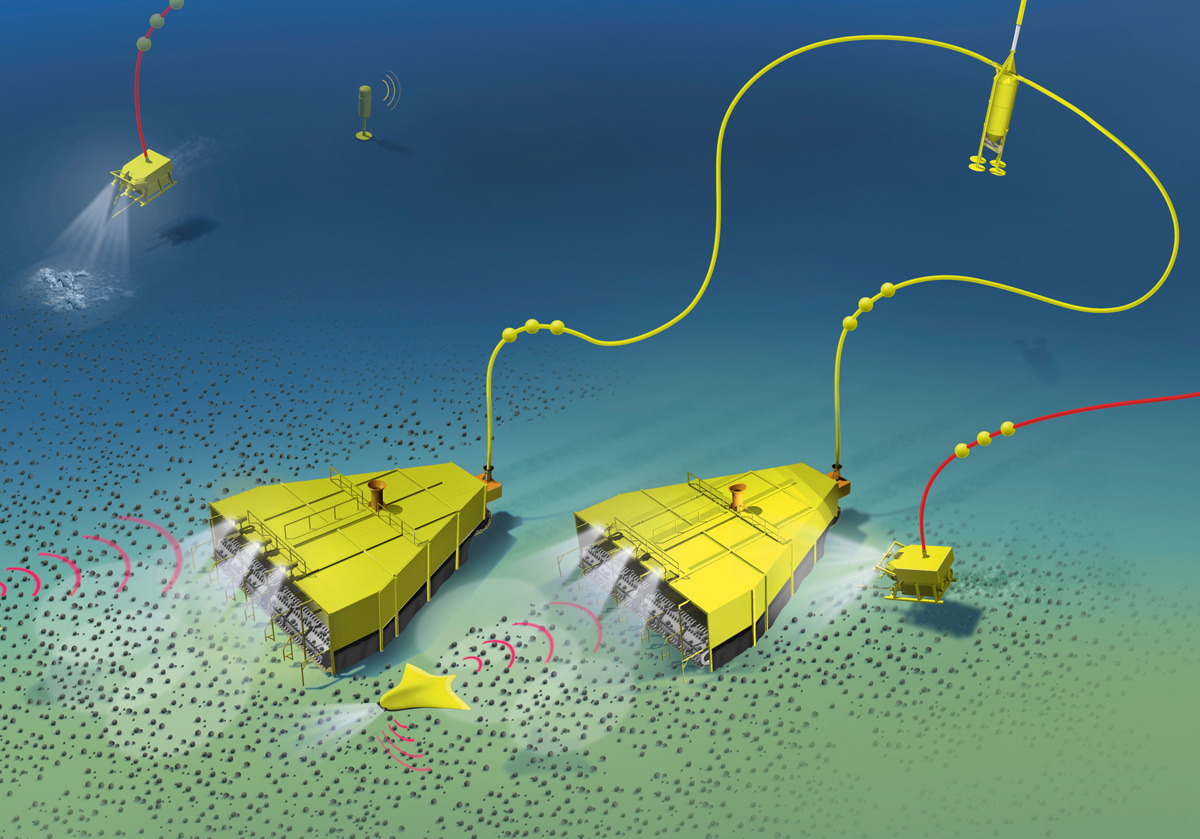
Innovation is the buzzword when it comes to developing the potential of Canada‘s mineral resources. Difficult conditions in the north of the country, mining depths of more than 2,500 m and tougher legislation on the environmental impact of mining operations all provide starting points for the market entry of German companies. And there are also opportunities for German suppliers in southern Africa, where there are huge reserves of mineral resources spanning the entire value-added chain. However we should not ignore the problems that may arise when seeking to establish business ventures in this region. These range from a lack of infrastructure to the tough competition that will come from established providers from other countries.
What kind of strategy should German companies adopt when operating in a mining sector that is in a worldwide slump? Australia is now inviting attention from prospective market players, who will have to be aware of country-specific and legal realities as well as market circumstances.
With my best regards,
Dipl.-Ing. Andreas-Peter Sitte
Chief Editor Mining Report Glückauf
Issue 04/2015
“Innovation in Canada’s Mineral Development Model” was the theme of the 19th National Mining Week, which took place in Canada from May 11 to 15, 2015. The fact that a Mining Week is held demonstrates the important role mining plays in the lives of Canadians and the awareness for this sector in society. The theme reflects a trend as well as a commitment: to support the mining sector in its efforts to remain a global leader in minerals and metals, with innovation driving responsible and sustainable development of Canada’s natural resources, creating jobs and future prosperity. This article will present some of the main trends driving the development of Canada’s natural resources sector: Canada as a new supplier of strategic minerals such as rare earth elements; the expansion of exploration and mining efforts to the North and the Arctic; and the focus on innovation to meet technological and environmental challenges, including research to extend mining to depths greater than 2.5 km.
Author: Dr. Bruno Wiest, Leitender Beauftragter für Wissenschaft und Technologie, Botschaft von Kanada, Berlin

Africa’s growing importance for the global economy is clearly visible in the increasing activities of companies from around the world. Countries such as France and the US have long been heavily represented in Africa, while others such as China, India and Brazil have been increasing their presence for more than a decade. German industry is also present, but is so far keeping a lower profile than in other world regions. Although German companies are well-equipped in many areas for success on the African market, they have so far avoided entering it. Yet numerous opportunities for German suppliers exist along the entire value-added chain, from exploration to processing. Opportunities particularly worthy of note are those in process optimisation, resource efficiency, technology development, modernisation measures for above and below ground, post mining, and education and further training.
Author: Peter von Hartlieb, Bereichsleiter Netzwerk Bergbau, EnergieAgentur.NRW, Düsseldorf
Learn more

Figure 1: Growth in GDP (1)
Bild 1: Entwicklung des BIP (1)
Australia‘s mining industry has reached the end of its super-boom period. Price collapses in the resource sector, caused by an oversupply on the world market and a decline in demand from China, have put an end to a capital-intensive investment phase that lasted more than ten years. The industry has now entered a phase of short-term targets where the main focus is on plant and process optimisation, cost cutting, productivity improvements and greater cost and energy efficiency. With the mining industry seeing an increasing number of insolvencies affecting both operators and suppliers, the decision to enter the Australian mining supply market should now be given serious consideration. Because of country- and market-specific circumstances it is essential that any market entry strategy is adjusted and aligned to the product or type of services involved. With lead-times to the contract award phase typically amounting to several years in this sector, such ventures require flexibility, good planning and a realistic investment horizon that is funded over several years.
Author: Dr. Bernd Länger, Kompetenzzentrum für Bergbau & Rohstoffe der Deutsch-Australischen Industrie- und Handelskammer (AHK), Sydney/Australien
Learn more
The Zinkgruvan Mine is Sweden’s southernmost mine located approximately 200 km south-west of Stockholm at the northern end of lake Vättern. The primary metal is zinc, secondary metals are lead, copper and silver. The Zinkgruvan Mining AB plans a 20 % increase of processed ore until 2022. This article examines the production processes and performs a value stream analysis of the production flow. The focus deals with implementing an Overall Equipment Effectiveness measurement and the simulation of the haulage capacity. The article is a conclusion of the author´s graduation paper at the Rheinisch-Westfälische Technische Hochschule (RWTH) Aachen. For his excellent examination he got the Helmuth-Burckhardt-Award by Vereinigung Rohstoffe und Bergbau (VRB), Berlin, in September 2014.
Author: Daniel Schäfer M. Sc., Institute of Mining Engineering I (BBK I), Rheinisch-Westfälische Technische Hochschule (RWTH) Aachen, Aachen/Germany
Learn more


Fig. 5. Two self-propelled collectors are winning manganese nodules from the seabed. The crushed nodules are pumped via flexible pipes to a temporary storage they both share (top right), from where the ore-water composite is pumped via tubing to the productionship.
Source/Quelle: M.H. Wirth.
The rising global demand for metals is starting to focus greater attention on the extraction of marine mineral resources (MMR) from deep sea. The term MMR essentially covers three different types of formation: manganese nodules, cobalt-rich ferromanganese crusts and massive sulphide deposits. All three of these natural resources provide the potential basis for a whole range of different metals. Germany has developed an interest for the exploration of marine deposits. This paper outlines the types of deep-sea deposits available and their resource potential. It also describes the legal and commercial parameters involved and presents the challenges that will arise during the mining and extraction phase and the possible environmental impact of such operations.
Authors: Dr. Michael Wiedicke, Arbeitsbereichsleiter Meeresgeologie/Tiefseebergbau, Dr. Thomas Kuhn, marine Lagerstättenmodellierung, Dr. Carsten Rühlemann, Leiter Exploration von Manganknollen, Dr. Annemiek Vink, umweltbezogene Untersuchungen, Dr. Ulrich Schwarz-Schampera, Leiter Exploration mariner Sulfide, Bundesanstalt für Geowissenschaften und Rohstoffe (BGR), Hannover
Learn more
From 2013 to 2014, Germany’s domestic lignite output dropped 2.6 % from 183.0 Mt to 178.2 Mt. The 2014 figure is equivalent to a net calorific value of 55.2 Mtce. Of the total output, 159.1 Mt, or some 89 %, was used in utility power plants for the public supply, i.e. 3.0 % less than in the previous year. In addition, 15.0 Mt was input in the factories of the lignite-mining industry to make solid products, while 2.1 Mt was used to generate electricity in mine-mouth power plants. Other sales of raw lignite and changes in stocks accounted for 2.0 Mt. Lignite made a 25.4 % contribution towards Germany’s total power generation in 2014.
Authors: Dipl.-Volkswirt Uwe Maaßen, Geschäftsführer Statistik der Kohlenwirtschaft e.V., Köln, Dr. Hans-Wilhelm Schiffer, Executive Chair World Energy Resources, World Energy Council, London
Learn more

Australia is one of the biggest mining countries in the world. In spite of the current recession, the mining industry has continuously grown throughout the past decades. This predictable continuing development in the upcoming decades can undoubtedly be traced back to Australia’s vast and often unexploited landmasses. The country possesses about 10 % of the world’s known coal deposits. It further harbors great amounts of iron ore, bauxite and copper. Australia plays an important role in the global supply of raw materials. Many German companies are toying with the idea of entering Australia’s large and attractive market that is characterised by gigantic and continuously growing reserves and compels due to the possibility of outstanding revenues. Yet, how is it possible to minimize the risk and the expenditure for expansive contracts, exorbitant procedures and elaborate rules governing compliance? This article will provide answers to these questions. It is mainly based on a lecture held by the author at the Australian embassy in Berlin on the 25th of March 2015 entitled “The Future of Mining in Australia. Technology. Innovation. Sustainability. Finance.”
Author: Dr. Dr. h. c. Wolfgang Babeck, Partner der Rechtsanwaltskanzlei Buse Heberer Fromm, Sydney/Berlin, und adjunct Professor an der Law Faculty der Bond University, Robina/Australien
Learn more
Exploration expenditure is closely linked to commodity prices and in the current low commodity price environment pressure on exploration budgets and reduction in spending has been dramatic. This calls for making robust business cases for exploration spending to demonstrate value-added to senior management. This contribution examines exploration and related resource definition in the context of the mine production value chain which is conceptualized by means of Theory of Contraints. This framework allows to link uncertainty around the deposit being mined with production costs and hence deriving a value to improved resource definition. A demonstration study in a bulk commodity shows the application of the framework with impressive cost savings and return on capital achievable, supporting a business case for considerable resource definition spending. The Value of Information concept is introduced to help establishing upper bounds for expenditure on a project.
Author: Dipl.-Geol. Volker Osterholt (MPhil. Geostatistik), Principal Consultant, Osterholt Consulting, Darmstadt, Germany
Learn more





